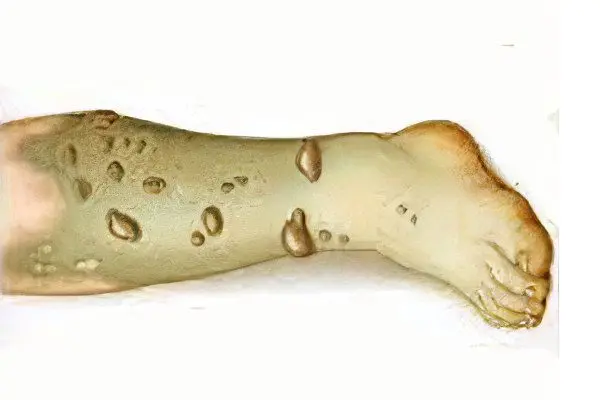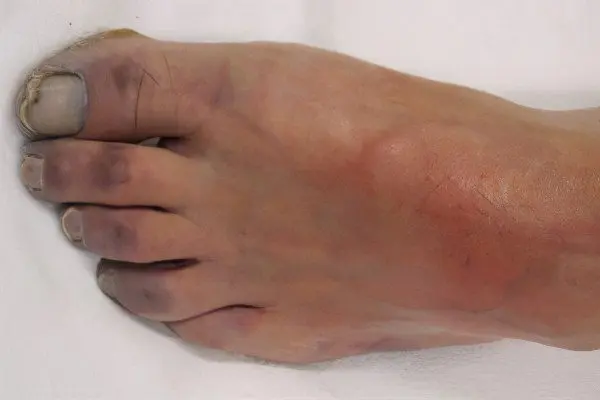Contents
A type of necrotic tissue breakdown that has arisen as a result of a lack of blood circulation due to trauma, a blood clot entering a vessel, a bone fragment during a fracture, as well as metabolic and vascular disorders in patients with diabetes mellitus, is called wet gangrene.
About the disease

With this form of gangrene, the tissues of the body undergo putrefactive decomposition. The disease proceeds rapidly, it is characterized by an extremely unfavorable outcome due to the rapidly increasing intoxication of the body. Most often, gangrene occurs on the upper and lower extremities, although it also occurs in the lungs, intestines, and gallbladder. If the patient does not perform urgent amputation of the affected limb or organ, a fatal outcome is inevitable.
The catalyst for wet gangrene is always infection with pathogenic bacteria. As a result of their activity, the process of cadaveric decomposition starts in the tissues of the body. The patient’s immune system is not able to delimit the affected area of the limb or organ from healthy tissue. The necrotic process rapidly spreads further, and the toxins resulting from the breakdown of a large number of cells enter the systemic circulation, disrupting the functioning of the body.
Gangrene of this type is especially difficult in patients with diabetes mellitus for the following reasons:
Low body resistance;
Increased susceptibility to septic and purulent infection;
Violation of the regenerative properties of tissues.
Gangrene of the lungs and intestines always proceeds in a wet type.
Causes of wet gangrene

A sudden circulatory disorder that provokes the onset of pathology is always based on a vascular accident or injury.
Deadness – traumatic causes:
frostbite;
Thermal or chemical burn;
Open wound with damage to a large artery;
Crushing or mechanical crushing of tissues;
Compression of blood vessels (with a long-term hemostatic tourniquet);
A small wound or abrasion in patients with diabetes;
Closed comminuted fracture with damage to the artery.
Wet gangrene – vascular causes:
Vessel embolism when a blood clot enters it, a piece of adipose tissue during a fracture;
Atherosclerosis – overlapping of the vessel lumen with a cholesterol plaque;
Obliterating endarteritis – narrowing of the vessels of the extremities in smokers;
Thromboembolism of the pulmonary artery, which caused pulmonary gangrene;
Infringement of a hernia that caused intestinal gangrene;
Compression of the gallbladder wall with a stone, which caused gangrene of this organ.
Not every wound or compression of tissues leads to the appearance of necrotic changes. Strong prerequisites are necessary for the beginning of the pathological process.
Predisposing factors:
Features of metabolism in overweight patients;
Avitaminosis;
Exhaustion;
Endocrine pathologies in history;
Infectious diseases;
Additional intoxication with alcohol, nicotine, chemicals;
Transferred traumatic shock;
Overheating or excessive cooling of blood vessels in combination with impaired blood supply;
Destruction of body structures by aggressive media (alkali, acid), electric current;
Infection of tissues with pathogenic microbes;
Heart and kidney failure, provoking additional edema, disrupting metabolism;
Damage to the main vessel, as a result of which the blood supply to a large area of uXNUMXbuXNUMXbthe body is disturbed.
Streptococci, Escherichia coli, and enterobacteria are involved in wound infection with wet gangrene. Most often they enter the wound with a gunshot or stab wound, although they can enter the body from the soil or with a nosocomial infection.
Symptoms of wet gangrene

In the initial stage of the disease, the limb becomes cold, the vascular network appears on it, the skin acquires a marble pattern. The movements of the arm or leg are limited or impossible, the pulse is weak or completely absent. In this case, the patient experiences severe pain. The deterioration occurs after 1-2 days from the onset of the disease.
Symptoms of the further development of wet gangrene:
There is a strong, rapidly growing edema, spreading throughout the limb;
Blisters appear on the skin with red or brown hemorrhagic fluid;
The structures of the limb are exposed, they have a dirty gray color;
The skin in the affected area becomes blue or black with a greenish tint;
Decaying tissues and waste products of bacteria produce an extremely unpleasant putrefactive odor;
A dirty green or brown exudate of a liquid consistency is released from the wound, in the muscles it takes the form of a thicker substance;
From the periphery of the limb, necrosis rapidly spreads to the center, there is no clear boundary between the affected and healthy tissue.
The increase in intoxication entails the appearance of symptoms of general poisoning:
Heat;
Weak pulse;
low blood pressure;
Apathy;
Gray complexion;
dry tongue;
Headache;
Fatigue, weakness.
With gangrene of the lungs, a persistent cough occurs, expectoration of a large amount of fetid sputum (up to a liter per day). There is severe pain in the chest, which becomes more intense with inhalation and deep breathing. Wet gangrene of the lungs proceeds at lightning speed, patients die in the first few days.
With intestinal gangrene, the patient is diagnosed with constipation, bloating, blood in the stool, nausea and vomiting. The stomach hurts, the body temperature rises rapidly. If the patient is not provided with urgent assistance, intestinal gangrene is complicated by peritonitis and leads to death.
How is the disease diagnosed?

Symptoms of wet gangrene should be referred to a vascular or general surgeon. Treatment of wet gangrene is carried out in the department of purulent surgery, with diagnosed gangrene of the lung, a thoracic surgeon can help. At the initial appointment, the doctor is interested in whether the patient has diabetes mellitus, cardiovascular diseases.
When visually inspecting the wound, the surgeon pays attention to the following parameters:
Color of the skin;
The presence of edema;
skin condition;
The presence or absence of crepitus (a characteristic crunch).
When the diagnosis is confirmed, the patient is sent to the hospital for a complete examination and treatment.
Laboratory and instrumental studies:
General and biochemical blood test;
Blood test for sterility to detect sepsis;
Bacteriological sowing of exudate to identify the sensitivity of pathogens to antibiotics;
X-ray of the limb;
Bronchoscopy, CT or chest ultrasound for suspected pulmonary gangrene;
Microscopic and bacteriological examination of sputum with gangrene of the lung;
X-ray of the abdominal cavity to determine signs of intestinal necrosis;
Laparoscopy to identify lesions in wet intestinal gangrene.
If the patient requires resuscitation, he is transferred under the supervision of a resuscitator.
Treatment methods for wet gangrene

Partial removal of tissues that have undergone necrosis is ineffective in wet gangrene. Most often, a radical method is used – guillotine amputation of a limb to healthy tissue. The operation is carried out in 2 stages – first, an amputation is performed, and after cleansing the wound, a stump is formed.
The main directions of treatment:
Amputation of the focus of necrosis;
Elimination of the infectious factor;
Relief of general intoxication of the body;
Correction of metabolism in diabetes mellitus.
With gangrene of the intestine or gallbladder, a diagnostic and therapeutic laparotomy is performed with the removal of a necrotic organ, sanitation of the abdominal cavity.
Drugs to eliminate the infection:
Broad spectrum antibiotics;
Local antiseptics;
Sulfonamides;
Nitrofurans;
Immunomodulators;
antigangrenous sera;
Vaccine.
Detoxification activities:
Transfusion of blood substitutes (plasma, blood, albumin, hemodez);
Infusion (droppers) of glucose, colloid and crystalloid solutions, isotonic sodium chloride solution, low molecular weight polyglucin;
Forced diuresis of diuretic and cardiac glycosides;
Plasmosorption;
Hemosorption;
Ultraviolet irradiation of blood.
With wet gangrene, complications associated with impaired functionality of the heart, kidneys, and liver may appear. Gangrene of the lung can be complicated by pulmonary bleeding, the development of sepsis. Peritonitis and sepsis, which complicate the course of intestinal gangrene, often cause the death of the patient.
For the prevention of wet gangrene, burns and frostbite, infections of the respiratory system should be treated in a timely manner. Proper treatment of vascular pathologies, prevention of foot injuries in diabetes mellitus will help prevent the onset of the disease.









